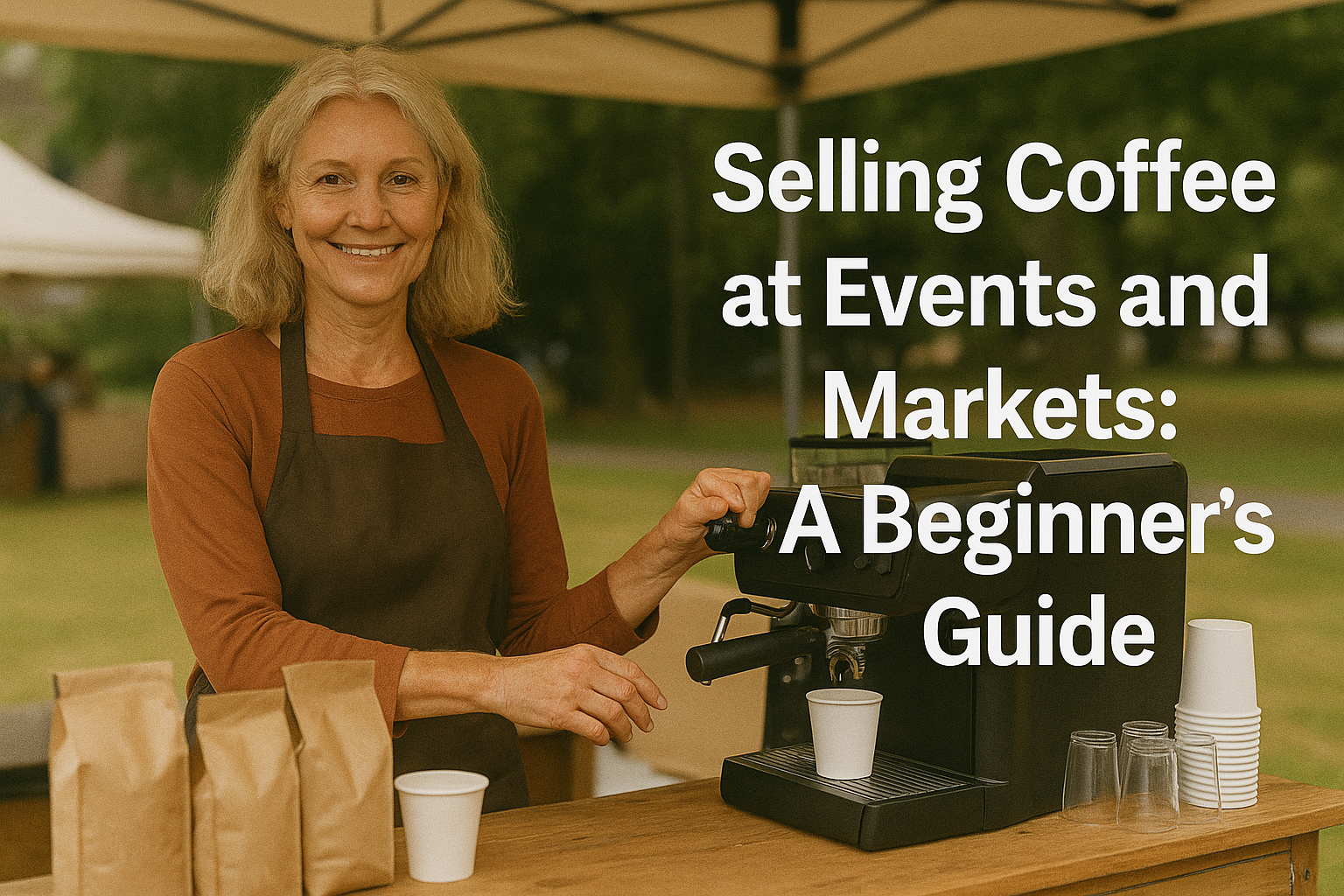If you’re a barista or coffee enthusiast looking to break into business without opening a full café, selling coffee at events and markets can be a powerful first step.
Whether it’s a farmer’s market, a local festival, a craft fair, or a wedding, event-based coffee service allows you to showcase your skills, build your brand, and generate real revenue — with far less overhead than a brick-and-mortar café.
This guide will walk you through everything you need to know to start selling coffee at events successfully, from preparation to permits to maximizing your profits on the big day.
Why Events and Markets Are a Smart Starting Point
Selling coffee at events is more than just a side hustle — it can be the foundation of your coffee business. Here’s why it works
Low startup cost: You don’t need a storefront, just equipment and setup Freedom to test and refine your concept before scaling You meet potential customers face-to-face — and build real relationships Great marketing exposure with little to no ad spend High energy and foot traffic in a short period of time
Whether you’re a mobile barista or building toward your own brand, events give you the freedom to learn, grow, and profit — one cup at a time.
Know Your Coffee Format
Before you book your first event, decide how you’re going to serve coffee. Your setup will influence what kind of events you can handle and how much you can earn.
Here are the most common coffee service models
1. Espresso bar
Requires espresso machine, grinders, power supply, milk storage, and water setup. Great for weddings, corporate events, or higher-end markets. Slower, but high profit per cup.
2. Cold brew tap
Simpler to set up, faster to serve, ideal for warm-weather events. You can batch the coffee in advance and serve on tap or bottle. Low cost, high volume.
3. Pour-over or batch brew
Perfect for farmer’s markets and craft fairs. Requires minimal gear and setup. Easy to train others and keeps the workflow smooth.
4. Specialty drinks
Signature lattes, matcha, chai, and seasonal flavors can set you apart. Pre-make bases and keep it streamlined to avoid long wait times.
Choose a model based on your resources, the type of crowd, and your level of experience. Simpler is often better — especially in your early events.
Research and Choose the Right Events
Not all events are created equal. Some are perfect for coffee sales, others may be a waste of time (and energy).
Look for events with
High foot traffic and long duration (at least 4–6 hours) Mornings or early afternoons (prime coffee time) Limited beverage competition (not 10 other coffee vendors) A price point that fits your menu (craft fairs vs food festivals) Opportunities to showcase your brand (not just sell drinks)
Great options include
Weekend farmer’s markets Music and art festivals Corporate expos Community fairs and holiday markets Yoga or wellness events Conferences and creative industry meetups
Start small and local. Once you find events that match your energy and niche, build relationships with organizers so you can return regularly.
Understand the Permits and Legal Requirements
Even if you’re just selling coffee for one day, you’ll likely need permits — and they vary depending on your location.
Here’s what to check
Business license
Basic requirement to sell anything legally under your name or brand
Temporary food vendor permit
Usually required for markets and festivals. Often includes a quick inspection.
Food handler’s certification
Shows you understand basic food safety. Easy to get online in many places.
Mobile food license or health inspection
If you’re using a cart, trailer, or truck with plumbing and refrigeration, you may need a more detailed inspection and facility registration.
Sales tax permit
Allows you to collect and submit taxes on each sale. Some events require proof in advance.
Visit your city or county’s website or call the small business department for a checklist. Permits often take time to approve, so start early.
Build a Portable, Functional Setup
Your setup should be efficient, eye-catching, and portable. Don’t overcomplicate it — you need to move fast and serve well in limited space.
Essentials include
Folding table(s) or compact bar/cart Canopy or umbrella for outdoor shade Insulated containers for coffee or milk Water jugs and sanitation supplies Clean signage with your menu and pricing POS system (Square, SumUp, etc.) or cash box Portable power source (if using equipment) Trash and recycling containers
Don’t forget small but important extras like napkins, stirrers, and milk alternatives. Pack extra — events are unpredictable.
Pro tip Keep your gear in color-coded or labeled containers. Load-in and load-out will be faster and less stressful.
Keep the Menu Tight and Profitable
A common mistake at events is offering too much. Long menus slow down service, confuse customers, and increase prep time.
Stick to
3–5 core drinks you can make quickly and consistently 1–2 signature options (a seasonal latte, a unique cold brew) Clear pricing (rounded numbers are easier in person) Optional add-ons like plant milk, syrups, or extra shots
Focus on drinks that offer high perceived value and low ingredient cost. Cold brew, for example, has an excellent margin when batched in bulk.
Make your signage big, clean, and easy to read from a distance. People decide fast — and long lines scare them away.
Price Smartly for Events
Event pricing is different from café pricing. People expect to pay a bit more for convenience, experience, and uniqueness.
Standard ranges
Hot coffee or batch brew $3–$5 Cold brew $5–$7 Espresso-based drinks $4–$7 Signature drinks or matcha $6–$8
Add $1–$2 for plant-based milks or extra shots if your market allows it. Be confident in your pricing — you’re offering more than just a drink.
If the event takes a vendor fee or percentage of sales, factor that into your pricing strategy.
Promote Before, During, and After the Event
Don’t just rely on foot traffic. Use the event as a marketing moment.
Before the event
Post teasers and “we’ll be here” announcements on social media Run a giveaway for a free drink if they show up or tag you Email your list with a special offer for that event
During the event
Encourage photos and tags with a branded hashtag Offer a small discount for Instagram or TikTok shoutouts Collect emails or phone numbers for future events
After the event
Post highlights, thank customers, and share behind-the-scenes Reach out to any interested collaborations or nearby vendors Review what sold best and what could improve next time
Each event builds your visibility. Even if someone doesn’t buy today, they’ll remember you for next time.
Prepare for Challenges
Markets and events are fast-paced and unpredictable. Be ready for
Weather issues (have covers, weights, or indoor options) Equipment malfunctions (always bring backups or tools) Long days on your feet (wear good shoes and hydrate) Cash shortages (have change ready or promote digital payments) Running out of stock (better than overstocking — but have a “sold out” plan)
The more events you do, the easier it becomes. Build a checklist and refine it after every experience.
Track Your Numbers
Treat each event like a business — not just a fun day out.
Track
Total sales per hour Number of drinks sold (by type) Best-selling items Peak times and dead times Average sale per customer
This data helps you price smarter, prep better, and predict future needs.
Use a simple spreadsheet or POS system with reporting features. After 3–5 events, you’ll see patterns that can shape your entire strategy.
Use Events to Test and Grow Your Brand
Selling at events isn’t just about one-day profits. It’s your chance to
Test new recipes and see what people respond to Introduce your brand to hundreds of potential fans Grow your social following and email list Drive future online or wholesale sales
Offer QR codes linking to your website or store. Bring a few bags of coffee or merch to sell if allowed. The goal is to make people remember you — and come back for more.
Final Thoughts: One Cup Can Open Doors
Selling coffee at events and markets is one of the most rewarding, low-risk ways to enter the coffee business world. It’s fun, fast-paced, and full of human connection — exactly what makes coffee culture so powerful.
You don’t need a big team. You don’t need a full café. You just need solid prep, a reliable setup, and a drink worth coming back for.
So go where the people are. Set up your station. Pour with confidence. And let your coffee start conversations that lead to something bigger.

Marcelo Rodrigues is a passionate barista with over 7 years of experience in specialty coffee. He’s worked in top cafés, led barista training sessions, and now shares practical tips to help beginners and coffee lovers improve their skills. Through this blog, Marcel makes the world of coffee more accessible—one cup at a time.

